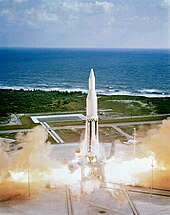SA-1 (Apollo)
| Mission emblem | |||
|---|---|---|---|

|
|||
| Mission dates | |||
| Mission: | SA-1 | ||
| COSPAR-ID : | SATURNSA1 | ||
| Launcher: | Saturn I | ||
| Begin: |
October 27, 1961 3:06:04 PM UTC |
||
| Starting place: |
Cape Canaveral Air Force Station LC-34 |
||
| Landing: |
October 27, 1961 3:21:04 p.m. UTC |
||
| Landing place: | Atlantic | ||
| Flight duration: | 15 min 0 s | ||
| Apogee : | 136.2 km | ||
| Covered track: | 331.5 km | ||
| Payload: | 2nd and 3rd level dummies | ||
| ◄ Before / After ► | |||
|
|||
SA-1 was the first test flight as part of the Apollo program and the first launch of a Saturn I .
aims
The size and power of the Saturn rocket family represented a new dimension in space travel . So NASA decided to conduct a separate test flight for each component of the rocket . The second stage was filled with water to simulate the takeoff weight. At the point of the payload was a Jupiter rocket tip. The sole aim of this mission was to test the functionality of the first stage.
Preparations
The rocket was delivered by sea on August 15, 1961. This was also seen as a test for the delivery of larger stages of future Saturn rockets. On the way there one had some difficulties with maneuvering and on the way back the transporter hit a bridge, causing minor damage. The assembly of the rocket began on August 20, followed by a number of tests on the launch pad. Due to minor problems, the schedule was slightly behind schedule, especially since the test processes were not yet automated.
For the flight it was important that the RP-1 fuel and the liquid oxygen (LOX) were refueled in the correct proportions so that these two substances were running out at the same time. However, the exact quantities could only be set shortly before the start. It was technically easier to drain RP-1 that had already been filled up and refill LOX, which is why more RP-1 and less LOX than calculated were filled up first. The associated measuring system should have an accuracy of 0.25%. In fact, there was an error of 0.4% because the temperature change along the fuel line was not taken into account. This means that 410 kg too little RP-1 and 400 kg too much liquid oxygen were on board, as it later turned out.
Flight history
On October 26, 17:30 UTC, the RP-1 tank was filled to 103%. At 8:00 a.m. the following day, the fuel was filled with LOX to a level of 10%. One hour before takeoff, both LOX and RP-1 were brought to 100%. After a ten-hour countdown with two weather-related interruptions, the rocket lifted off at 15:06:04 UTC.
The flight was a complete success, the rocket reached an altitude of 136.2 km and after a total of 15 minutes of flight it hit the Atlantic Ocean 331.5 km from the launch site . A little less than planned, as the engines shut down 1.6 seconds too early after a tank sensor reported that the fuel was exhausted.
This could partly be explained by the incorrect density measurement during refueling, which had led to too little RP-1 in the tanks, causing the RP-1 to run out about 0.6 seconds too early. Another second was attributed to the sloshing of liquids in the tanks. Only three of the nine tanks were fitted with sensors that also signaled unreliable data in some cases, so that no precise statement could be made about the contribution.
Trivia
The senior engineers only gave the new missile a 75% chance of even taking off from the launch site and only 30% expected the entire flight to be successful.
After the successful flight, preparations were made for the next test ( SA-2 ), in which the Highwater project should also be used.
Web links
- Saturn SA-1 Flight Evaluation December 1961 (English)
- Saturn SA-1 in the NSSDCA Master Catalog (English)
- Moon Port: A History of Apollo Launch Facilities and Operations (English)
- More NASA page on SA-1 (english)
Individual evidence
- ↑ a b NASA: Saturn SA-I Flight Evaluation. (PDF) December 14, 1961, pp. 26-28 , accessed on December 18, 2018 (English): "This magnitude of deviation would cause 888 pounds of LOX to be overtanked and 913 pounds of fuel to be undertanked and would result in an early engine cutoff of 0.6 seconds in flight. "
- ^ Eugen Reichl: Project Apollo The early years . 1st edition. Motorbuch Verlag, Stuttgart 2014, ISBN 978-3-613-03665-9 , pp. 20 .
- ^ NASA: Saturn SA-I Flight Evaluation. (PDF) December 14, 1961, pp. 109–113 , accessed on December 18, 2018 (English): "One consequence of the sloshing on SA-1 may have been some contribution to an earlier cutoff than predicted."
- ^ Charles D. Benson, William Barnaby Faherty: The Launch of SA-1. In: Moonport: A History of Apollo Launch Facilities and Operations. NASA History Office, 1978, accessed December 18, 2018 .

